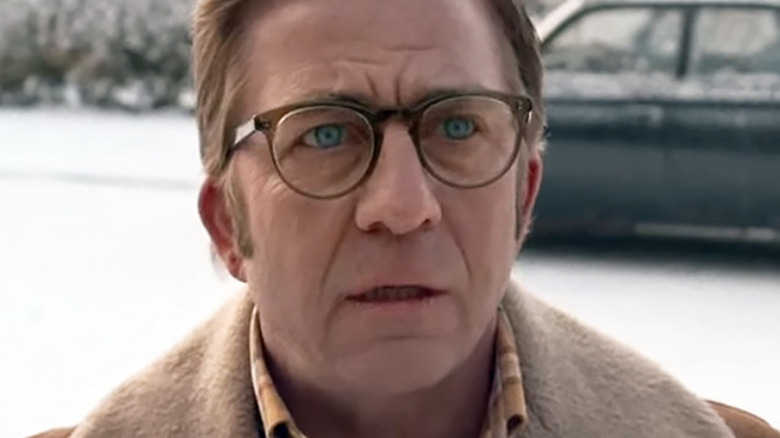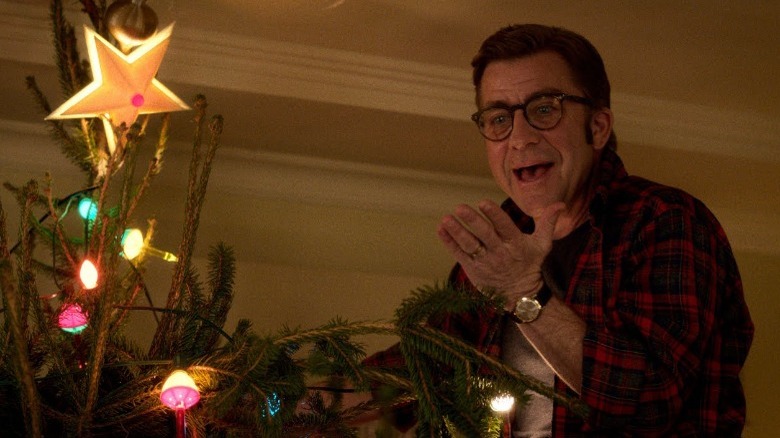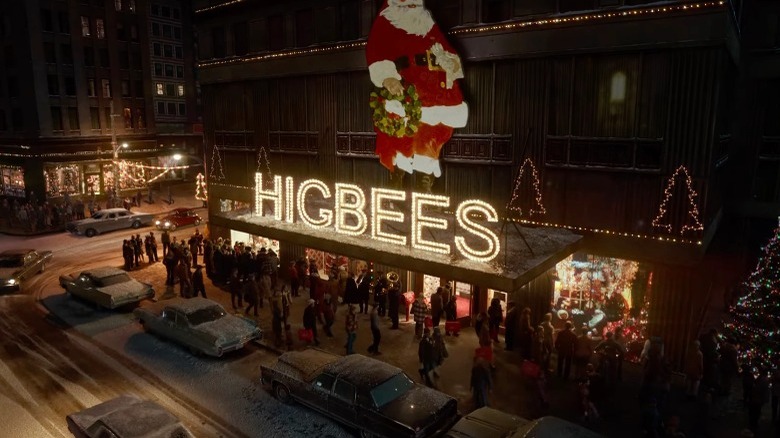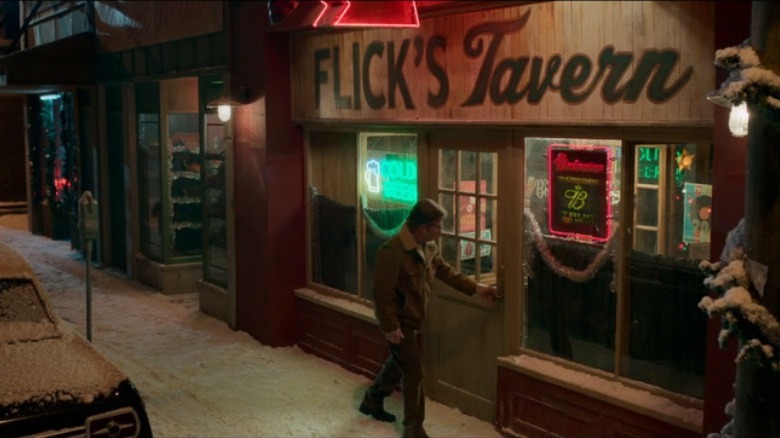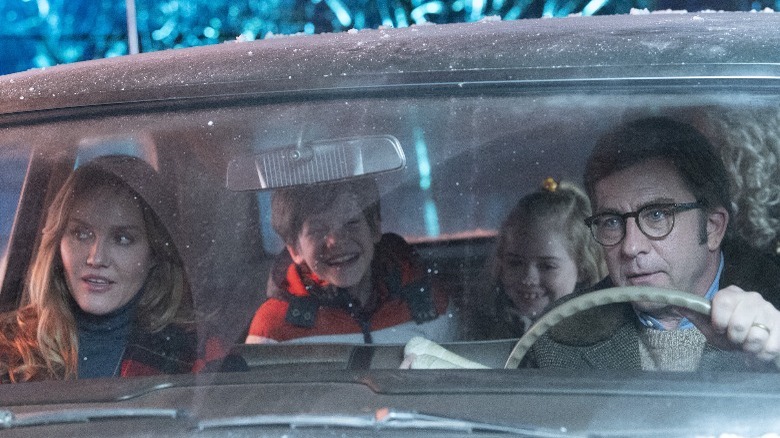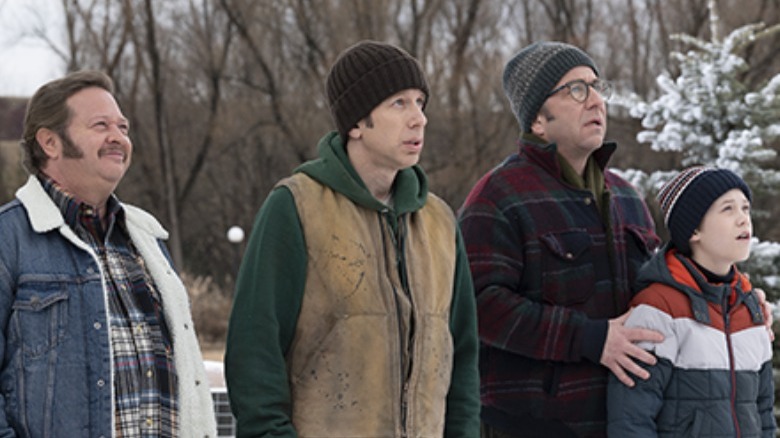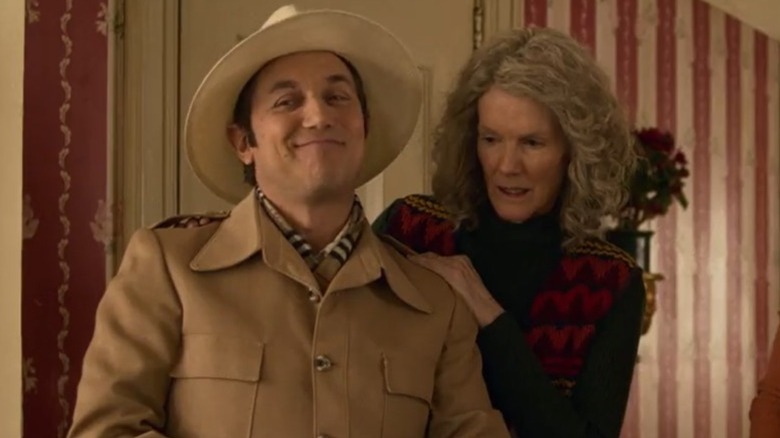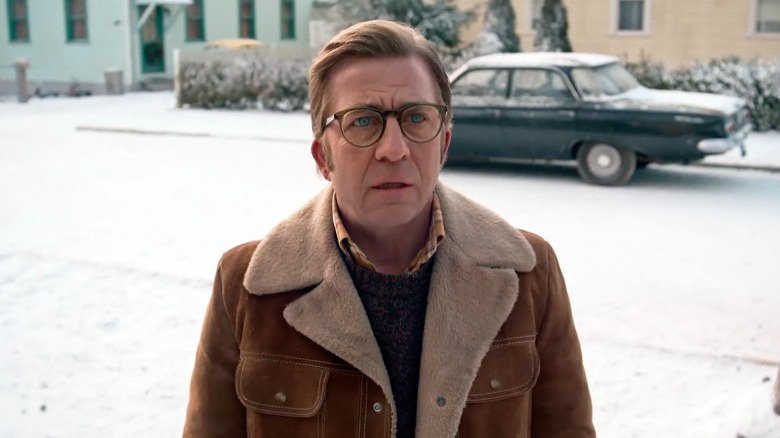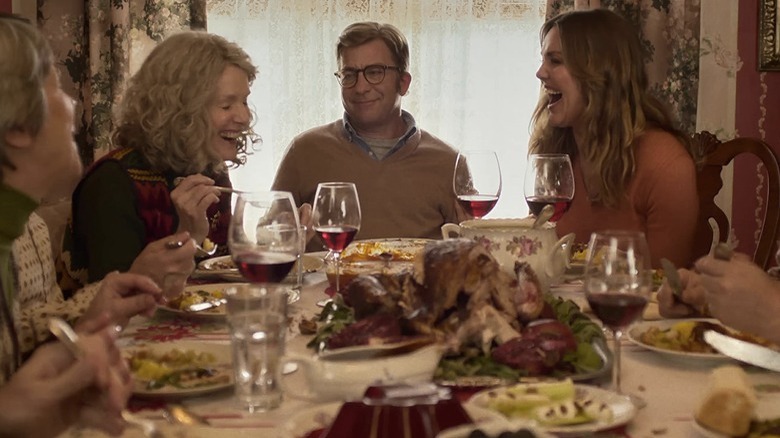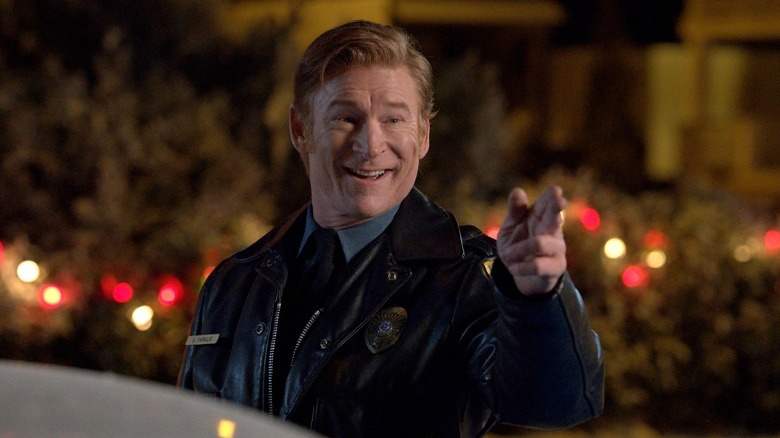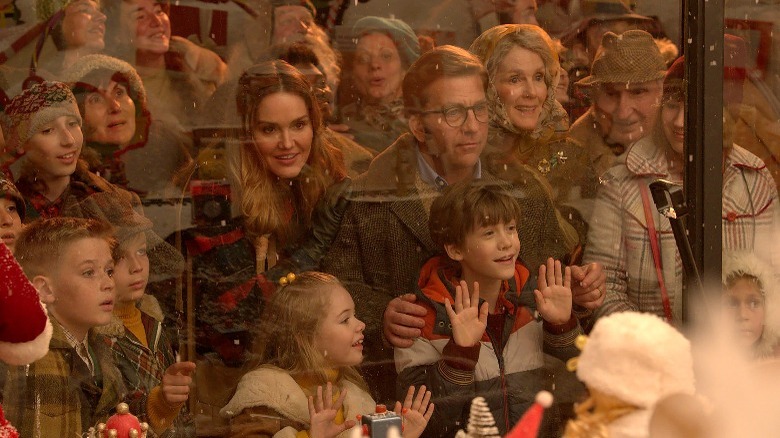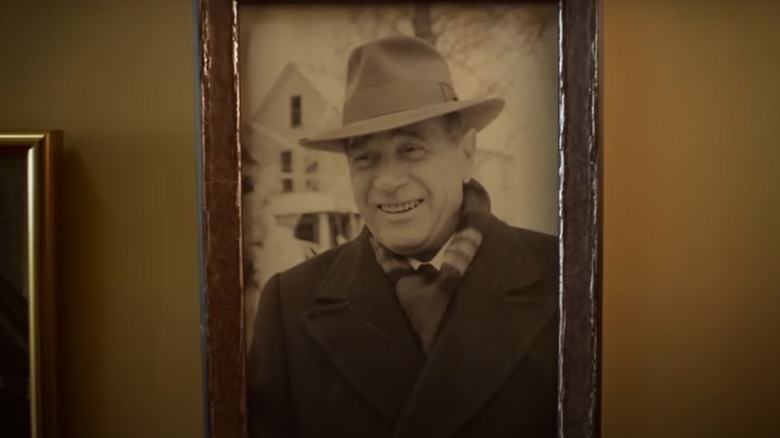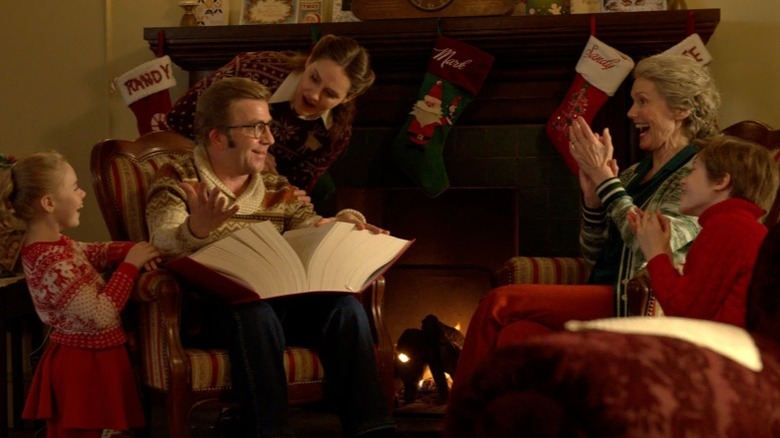The 6 Best And 6 Worst Things In A Christmas Story Christmas
"Sometimes, at life's most desperate moments, the universe offers us a sign," Ralphie (Peter Billingsley) narrates as he saunters beneath the neon glow of a "booze" sign. What might be Ralphie Parker's most desperate moment? Well, he has been appointed as the stand-in "Christmas ringmaster" following the passing of his Old Man. And he'd have you believe it's a task akin to the Herculean 12 labors.
"A Christmas Story Christmas" is the true-to-form sequel some fans of the nostalgic Christmas classic have been looking for. Peter Billingsley returns as the inimitable Ralphie with the same big blue eyes filled with hopes, dreams, and the occasional sense of wonder. But of course, he's now all grown up. With a wife, Sandy (Erinn Hayes), and two young children, Ralph has taken a sabbatical from work to aim for his dream to become a novelist. While hoping to land his big break, he receives the tragic news that his Old Man has passed away. So, the Parkers pack their things and head to Ralph's childhood home in Hohman, Indiana, to spend Christmas with his mother (Julie Hagerty).
As a sequel, "A Christmas Story Christmas" has rather big shoes to fill. Many of us know the original 1983 film by heart given its position as a Christmas viewing staple. But whether you're sick of the film, or an avid annual viewer sticking to rigid tradition, there's no mistaking that there's a quality of nostalgia affixed to the movie. The sequel often aims to unearth its predecessor's greatest moments. What results is a sequel that is heartwarming, but swings for the fences when aiming to capture the magic of the original for better and worse.
Best: Peter Billingsley back as Ralphie
Ralphie is inextricably the star of the original film. As a young lad, he oozed child-like awe, imagination, and whimsy with every line and facial expression delivered. In fact, most of us likely see our young selves in Ralphie just based on the circumstances of a youthful mind's perspective of the world. We remember that mindset and likely often miss its naivete and innocence. With Ralphie, there is never any doubt that his brain is running at 100 miles a minute even when we aren't apprised of the imaginative daydreams he's known for.
Peter Billingsley defined Ralphie as a youngster and, thankfully, he has the opportunity to continue that legacy. Even as an adult, Billingsley deftly conveys the mannerisms of the Ralphie we once knew combined with many years of aged wisdom and experience. He still has a penchant for daydreaming, but don't we all? Be honest with yourself. And somewhere deep within him is a man hoping that he can do right by his family while achieving his own dream. Billingsley exacts the charm and dry wit of Jean Shepherd's adult Ralphie narration in the original film. While Shepherd's iconic voice might be missed at first, the absence is quickly forgotten as Billingsley soundly performs the role. Regardless of how you feel about the sequel film, Billingsley is easily the best part of the entire experience.
Worst: Nostalgia sometimes feels forced
As a successor to a nearly 40-year-old film that is still highly regarded to this day as one of the best Christmas movies of all time, there's a lot to live up to. Understandably, it's easy to believe that the sequel will not live up to the 1983 classic. And, you'd be right. But let's be honest, is there any way to truly outdo a classic based on one family's Christmas story? It's kind of a one-and-done gig. So, if a sequel were to be made, it's probably wise to set your expectations appropriately. That doesn't mean "A Christmas Story Christmas" is a disaster. On the contrary, it's really quite fun. But those who bet that the film would pull heavily from the original with references, flashbacks, and mirroring plot points throughout its runtime would win the jackpot.
A healthy dose of reflection on Ralphie's childhood past is to be expected. But "A Christmas Story Christmas" leans hard on those nostalgic feels. There are numerous scenes that strike a familiar image, such as Ralphie sitting with his mother in the dark by the Christmas tree just like his father and mother did in years past. On top of the return to Ralphie's childhood hometown and all of the memorable characters and locales like Higbees, the film is sure to show us every detail possible of Ralphie wading through his past — like finding the "deranged Easter bunny" pajamas in the attic. It's moments like these that often make the film feel more like a total homage to its predecessor than a standalone story of its own.
Best: The 1970s setting
"A Christmas Story" might be a 1983 film, but it was seemingly set at some time in the late 1930s or '40s. While the threat of war was likely looming over the American public, the joy and wonder of Christmas swept in and seemingly made the Parker family forget all about the troubles of the world. For each of us, it's a period piece that hearkened to the style of the era from the automobiles driven all the way down to the school Ralphie and his brother attended.
With Ralphie all grown up and rearing two youngsters of his own, the film is appropriately set at least three decades later in the year 1973, according to the calendar hanging in the Parker's Chicago home. While Ralphie's old childhood residence appeared "frozen in time" as he put it, the rest of the world around is catching up with the times. It's a film that didn't seem to miss a beat jumping ahead into an entirely different generation. Gone are the art deco styles of the '40s. Now, we're entreated to the mustard yellow and dense colors so prevalent in the '70s. Between the plaid-wearing shoppers and the dimly lit haze of Flick's Tavern, there are plenty of details that help us settle into the 1973 era. There's even the fun reminder that the modern comforts of cell phones are a distant dream as wives call the bar looking for their husbands. Humorously, all the patrons hunker down when the phone rings nervous that they're about to be caught "escaping" to the local tavern. "A Christmas Story Christmas" absolutely does 1973 justice.
Worst: The snowball fight
The 1983 original was often filled with hilarity and a dab of crassness — limited enough to maintain the aura of a family film. But the movie often triumphed with moments like Ralphie's admiration of the "glow of electric sex" in his living room with the famous leg lamp or the Old Man (Darren McGavin) doing battle with the furnace down in the basement. Some of the best family moments stemmed from "bad luck." When the Parkers have to resort to eating Christmas dinner at a Chinese restaurant due to the Bumpus hounds massacring the Old Man's turkey, it is the sort of bad luck that makes us chuckle as the servers bring out a freshly cooked duck and summarily whack off its head at the dinner table, much to Mrs. Parker's horror.
The sequel attempts to capitalize on the traditional "bad luck" trope of achieving the perfect Christmas — something the original film, "Christmas Vacation," and many other holiday delights excelled at. Some moments work, and others fall a bit flat — like the snowball fight. You know the one. When the radiator overheats on the family's '66 Plymouth, they have to wait for it to cool down. To pass the time, they engage in a snowball fight which ends with Ralphie's daughter, Julie (Julianna Layne) getting pelted in the eye. As Julie laments her status as the resident cyclops after emerging from the doctor with an eye patch, we all get the joke: Ralphie almost shot her eye out, sort of. Even still, the moment doesn't have the same hilarious and crude feel of some of the original film's best scenes.
Best: The ramp
Alright, we said that there is a lot of focus on nostalgia in this film that often drove it more towards "homage" than a solid new Christmas story. But that doesn't mean that there aren't still some great tie-ins to the original film. Perhaps one of the most memorable sequences in the 1983 film is when Schwartz (R.D.Robb) "double dog" dares Flick (Scott Schwartz) to place his tongue on a metal pole out in the freezing cold to see if it sticks. He then issues in front of all of their classmates the fated "triple dog" dare — one that can't be refused lest a person be labeled a coward for all eternity. Flick regrettably follows through and ultimately winds up with his tongue stuck to a pole.
Somewhere in the middle of the sequel film, Schwartz and Flick get into a feisty argument in Flick's Tavern. It ends with Flick daring his old pal to go down "the ramp." Flick offers to toss Schwartz's entire bar tab if he does it. They head out to a ramp crafted by abandoned industrial-grade military equipment that is essentially a tall metal slide with an upward shot at the end coated in ice. As Ralph narrates, "you might as well be riding in your coffin." At the top of the slide, Schwartz attempts to back out, but Flick gets payback by issuing the "triple dog" dare in front of all the bar patrons. Humorously, Schwartz takes the ride and gets the wind knocked out of him. But he regains composure with a solid belch to disgust all who are hovering over him. It's a fun micro-thread that references the classic material but turns it on its head giving Schwartz the karmic punishment he's deserved for 30 years.
Worst: Randy's absence (mostly)
Ralphie's kid brother, Randy (Ian Petrella), may have not gotten the same spotlight Ralphie enjoyed in the original film, but he often added plenty to the family dynamic. Ralphie always laments having to watch out for his brother whether it be walking to school or standing in line with him to see Santa Clause. Like most younger siblings, Randy gives his older brother a run for his money. But also like most siblings, he truly cares for Ralphie. This is all too apparent when his mother finds him crying inside of a sink cabinet afraid that his father was going to "kill Ralphie" after his older sibling gets into a fight with the neighborhood bully, Scut Farkus (Zack Ward).
Randy always reminds audiences of our own younger siblings and it is often hard not to laugh at the true-to-life dynamic most might feel is so familiar in sibling relationships. Randy does appear in the sequel, but briefly. He makes one appearance mid-way through the film when he calls to check up on his mother following his dad's passing. He then arrives just in time for Christmas at the tail-end of the film. However, Randy could've easily bolstered the comedy in the film should he have been in the adventure from the beginning. In fact, his father's passing was reason enough for him to come home right away just like Ralphie did. Some of us were likely even asking, "where's Randy?" It was only when he would call home later in the movie that we'd get that answer.
Best: The day dreams
One of Ralphie's best qualities is his perpetual need to daydream his way through life's most harrowing moments, at least for a young kid. Whether it is viewing his teacher as the wicked witch of the west for giving his Red Rider BB Gun paper a C, or imagining a world where his family is remorseful for forcing him to put soap in his mouth for being vulgar causing him to go blind, there is never a dull moment when the fog of his imagination settles in.
Ralphie as an adult hasn't changed all that much. He still daydreams frequently. Some of his daydreams appear tempered by his experience with age, while others call back to the child-like whimsy of his youth. When he gets busted by Officer Farkus for breaking into Flick's Tavern and stealing a Christmas Tree star, he envisions a future where his family must get along without him since he's going to be spending his days behind bars. It's a bit much to imagine such extenuating circumstances for a simple breaking and entering charge. In his imagination, his family visits him in prison years later. His son Mark (River Drosche) has grown older and turned into a rebel with a British accent while his daughter Julie is pregnant with a wayward left eye thanks to his errant snowball. Ralphie's daydreams are often so exaggerated, which makes them laughable. Perhaps, this is why he has chosen to become a novelist after all.
Worst: Mrs. Parker's casserole hoarding
When Ralphie is a young lad, his mother prides herself on not being wasteful. She often pressures her kids to clean up their plates by guilting them with a reminder that there are other children in the world that don't have anything to eat. Apparently, her need to not be wasteful has only heightened with age. With the death of her husband, neighbors from all around deliver her various casseroles to offer condolences. She shares with Ralphie's family upon their arrival that they need to eat the casserole first before anything else just to ensure it's not wasted.
The casseroles are utterly gut-churning. It's a wonder that casserole is even an appetizing term given its association with an amalgamation of seemingly random foods from the refrigerator. As the Parker family plops different types of casserole on their plates, each is more repulsive than the last. At one point, Ralphie determines there are blueberries inside one of them.
When the family leaves the dinner table, Ralphie's mother picks up each plate and scrapes the remaining scraps back into the casserole dish to save for later. While this might be a humorous detail for some, the film's constant use of the supposed traditional Indiana "slop" is plain nasty, which is why this landed in the "worst" category. At the end of the film, local drunk Larry Novak (Henry Miller) polishes off all of the casseroles in a nauseating sequence just so the family can comfortably enjoy an actual Christmas dinner complete with a turkey. Come on, Mrs. Parker. Really?
Best: The growth of Scut Farkus
You remember Scut Farkus, right? He is the red-headed bully with the raccoon-skin hat that prowls the neighborhoods looking for youngsters to pummel and torment in the 1983 original film. Of course, Scut ultimately gets his just desserts at the hands of Ralphie when he chooses to mess with the little tike on the wrong day. Ralphie pummels the bully when provoked in a fit of rage after a long day. Randy brings their mother back to stop the fight which is really more of a beatdown that an actual brawl.
Well, after all those years Ralphie manages to see Scut again for the first time at the most unlikely moment. On Christmas Eve, the star at the top of the Parkers' tree falls off and shatters. Believing the holiday fib her father told her so she'd be at ease with a star instead of an angel, Julie becomes distraught over the idea that Santa won't visit them now. So, Ralphie breaks into Flick's Tavern to "borrow" the star off of his Christmas Tree. Police Officer Farkus answers the call for the disturbance and takes Ralphie for a ride in the back of his patrol car. While Ralphie feels like Scut is about to exact vengeance for the fight when they were kids, the policeman actually just takes him home. He then tells Ralphie that the thrashing he received from him that day changed him into wanting to be a better person. Wishing him a Merry Christmas, Scut gives him the star back and departs. While the film could've easily retread the bully scenario, it is actually quite refreshing and heartwarming that Scut has made something of himself despite coming from a rough home life, it seems.
Worst: The adult perspective
Part of the charm of "A Christmas Story" is that the narration is told from a child's perspective. Sure, the adult version of Ralphie is recounting the story, but he does so in a way that conveys young Ralphie's point of view at the time. In essence, "A Christmas Story" is all about the childhood nostalgia we all remember so fondly from our formative years. Like Ralphie recalling the best Christmas he ever experienced, the film stokes that same sense of remembrance in us.
The one problem with a sequel featuring the same characters is that we're now only going to get a story from the perspective of Ralphie as an adult whose worldview has been sullied by the stark realities of living day-to-day to make ends meet for his family. Ralphie has still retained some qualities from his childhood like his wild daydreams and his attempt to guilt his brother for being on a lavish business trip to India. But there's still the weight of balancing the pursuit of his dream and supporting his family financially. Adulthood comes with its own set of stressors, and unlike the original film, "A Christmas Story Christmas" often reminds us of that instead of helping us totally forget our woes in favor of childhood bliss.
Best: Honoring the Old Man
There is, of course, an empty void in the Parker residence that Ralphie is attempting to fill. The sequel's premise is based on the fact that Ralphie's Old Man has just passed away, and he decides to take his family home to be with his mother. Many of the original film's most hilarious and outrageous moments came at the behest of Old Man Parker's (Darren McGavin) ranting and raving at the irritations of the world. Unfortunately, any kind of return from the crotchety but loveable father is a no-go considering that the actor behind the role, Darren McGavin, passed away in 2006. And sure, Ralphie's mother is portrayed by Julie Hagerty instead of Melinda Dillon who has long been retired. But McGavin embodied the Old Man like no one else ever could.
Seeing as how a return wasn't possible for Ralphie's father, it's actually quite endearing to see that the sequel honors the character. Fans of the original can hear his voice again through flashbacks from the original film, and Ralphie strolls down memory lane constantly. It's even heartwarming to see that just like in the first film, the Old Man saves Christmas once again by preparing the best gifts for the grandkids before he passed. The homages to the character are not lost on fans, and it even doubles as a beautiful tribute to McGavin and his lasting legacy from the 1983 film.
Worst: Balancing death and joy
Here's the tough task for this film to overcome: managing the emotional heft of the death of Ralphie's father with the joy movies like this are supposed to exude in the Christmas season. The problem is that executing both is nearly impossible. As such, it often feels like much of the weight that comes with grief is swept under the rug. Of course, it's not that we want to watch a sequel to a whimsical Christmas classic be buried waist-deep in depressing circumstances. However, aside from Ralphie honoring his father's legacy, it doesn't feel like the entire family has fully embraced his death. The first question many might've asked when Ralphie arrives home in Indiana with his family is: Where is Randy? When we finally hear from Randy, he doesn't seem broken up about it at all. The funeral is even set aside so the family can "enjoy the holidays." It's asking viewers to suspend a lot of disbelief concerning the lack of grief.
On the other hand, there's a cloud that often hangs over Ralphie's head as he longs for his Old Man to be there with him celebrating the season. Of course, it's all made right in a small way when Mama Parker finds the gifts that the Old Man purchased for the family. But given the premise, anyone who has dealt with the death of a parent or close relative understands that tonally, some of this feels a bit unnatural.
